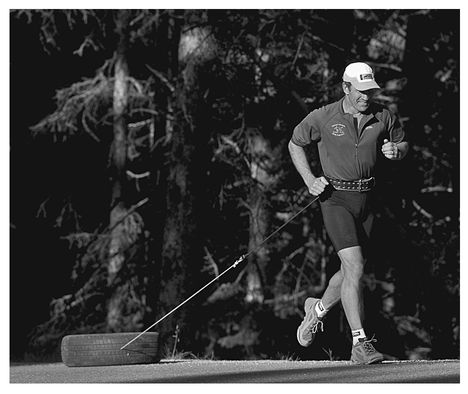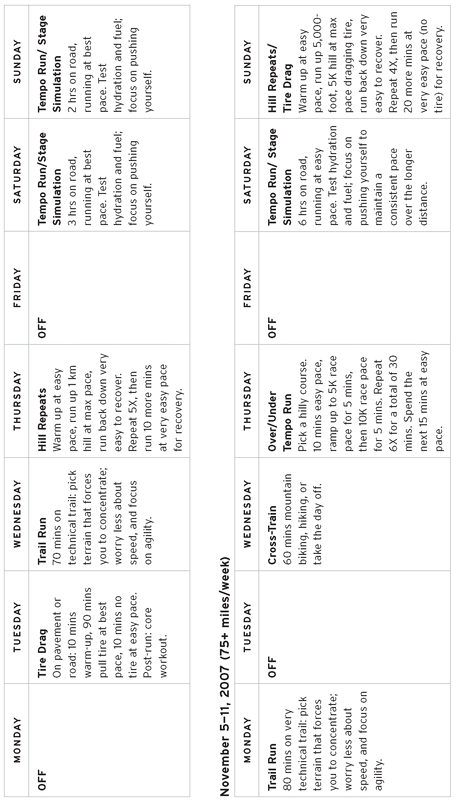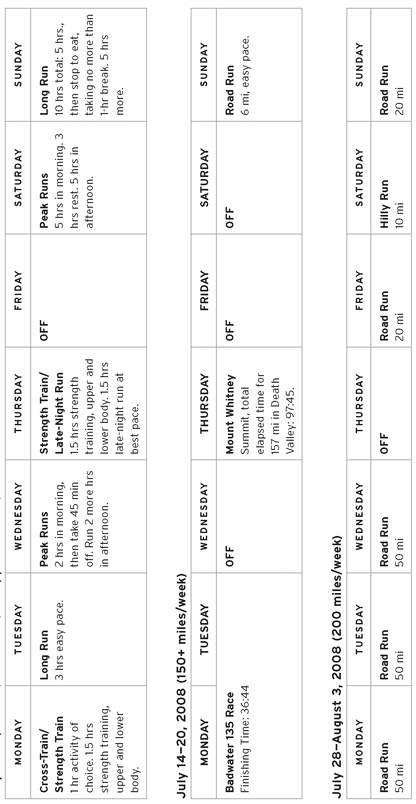Running on Empty (31 page)
Authors: Marshall Ulrich

To state the obvious, the absolutely greatest obstacle we encountered during this effort was, simply, the distance.
Yet it allowed us to amass some strange and surprising statistics: During the transcon, I lost only four pounds. I threw up only twice (after aspirating some food) and bonked only once. I drank no water, woreâand wore outâmore than thirty pairs of shoes and dozens of pairs of socks, and ran the equivalent of 117 marathons in well under two months, completing two each day plus a 10K, running over 120 hours and 400 miles per week, ascending over 84,000 vertical feet. At the age of fifty-seven, I attempted to break a record set by a twenty-eight-year-old and finished the third-fastest crossing ever made on that route.
One thing's for sure: This beat me up and beat me down, enough where I've wanted to stop running for good. After all, this was the last thing on my tick list. Going forward, the distances I travel will likely be far shorter, more traditional ultrarunning lengthsâone hundred miles or perhaps moreâand the speed at which I will complete them will be much slower. I'll be taking my time, savoring each moment as the clock keeps ticking and my feet keep moving. I'm in no hurry now, and when I put myself to the test, it has to be for a reason. No more running aimlesslyâin the past, I've sometimes used my athletic pursuits to run away, but I believe this accomplishment was more about running
through
. Things have changed. I once told a reporter that the reason we run extreme distances in harsh environments is that there's something in usâinstinct? primal urge?âthat wants to get out there, in the middle of nowhere, and think about something. My psychologist friend, Murray Griffin, suggests that it may be an evolutionary impulse, a drive to improve the species, to strengthen our stock. It's certainly a way of freeing ourselves, getting back to what I really believe people are supposed to be doing instead of relying so much on a bunch of material crap that only weakens us. We are built to walk and run, to cover great distances, for survival's sake. But now I think I may be able to satisfy that “something” in ways other than running. More Badwater races: yes, perhaps walking. More mountain guiding: yes, that's my favorite. Coaching people and helping them achieve their own goals? Absolutely. Anything else: Who knows? Really, there's nothing left to prove, and I don't feel the need to punish myself anymore. I've paid my dues.
through
. Things have changed. I once told a reporter that the reason we run extreme distances in harsh environments is that there's something in usâinstinct? primal urge?âthat wants to get out there, in the middle of nowhere, and think about something. My psychologist friend, Murray Griffin, suggests that it may be an evolutionary impulse, a drive to improve the species, to strengthen our stock. It's certainly a way of freeing ourselves, getting back to what I really believe people are supposed to be doing instead of relying so much on a bunch of material crap that only weakens us. We are built to walk and run, to cover great distances, for survival's sake. But now I think I may be able to satisfy that “something” in ways other than running. More Badwater races: yes, perhaps walking. More mountain guiding: yes, that's my favorite. Coaching people and helping them achieve their own goals? Absolutely. Anything else: Who knows? Really, there's nothing left to prove, and I don't feel the need to punish myself anymore. I've paid my dues.
This race may have answered many of my personal questions about my own psyche, but it's opened new ones. Before we began, my best explanation for why I had to attempt this crazy feat was “It's who I am.” Then who am I if I'm not running extreme distances? If I'm not out there pounding and in pain, who am I becoming? What's next for me? It's confusing to contemplate, but it feels healthy to apply myself to finding some answers. The next few years will be about rediscovery of myself, reinvention, and deepening and strengthening my already strong marriage. It will also be about reconnecting with family, about exploring a new kind of relationship with my now adult children, about rebuilding bridges with my brother, spending more time with Mom, saying “I love you” more often, and not letting old differences keep us apart.
My focus is changing, my intensity shifting, and that's okay.
Each year brings more thought, building the strength to succeed and the courage to fail. Each year brings more depth of character, more maturity, a greater understanding of the man I've become as well as the child who once aspired to scale Mount Everest. There was a maturation process, too, from the first 10K to the marathon to the ultras, adventure races, and mountaineering. Each event built on the others both physically and mentally. I thought I knew a lot about running before I started the transcon, but after finishing it, I know that I learned more during this one run than in all the other years of running combined. Still, all those early years were necessary to get me to that period in time, September 13 to November 4, 2008. Before then, I hadn't yet amassed the wealth of experience or, more important, partnered with the woman who could carry me through it, letting me run to my own outer limits of endurance every day, all the way. It would have been impossible to do without her being invested in helping me succeed.
It started with baby steps, that first run out the door of my house, attempting to get my blood pressure down and find some way to deal with the unimaginable. After that, it took dedication, hard work, and some support along the way. It was nearly thirty years of running to get to the starting line in San Francisco. And as morbid as it may sound, I wanted to live every day as if it were my last. This popular quotation, widely attributed to the writer Jack London, sums it up:
I would rather be ashes than dust! I would rather my sparks should burn out in a blaze than they should be stifled by dry rot. I would rather be a superb meteor, every atom of me in magnificent glow, than asleep and permanent as a planet. The proper function of man is to live, not to exist. I shall not waste my days trying to prolong them. I shall use my time.
I love to think about how Icarus was cautioned not to soar too high or his wings would meltâyet how else would he feel the warmth of the sun? Icarus flying close to the ground is like running in Death Valley during the winter:
Why do the easy, expected thing?
It takes guts to follow your dreams. Courage. Many people, even those who love you, don't understand how compelling that can be, and will try to keep you in the “safety zone.” But fuck that. Half the fun is venturing into the unknown, taking on the difficult task that yields new knowledge, doing more and testing your limits.
Why do the easy, expected thing?
It takes guts to follow your dreams. Courage. Many people, even those who love you, don't understand how compelling that can be, and will try to keep you in the “safety zone.” But fuck that. Half the fun is venturing into the unknown, taking on the difficult task that yields new knowledge, doing more and testing your limits.
Often when I'm addressing audiences, it's the eighty- and ninety-year-olds who really “get” my message, who come up to me afterward and say, “Bravo! Good for you.” Why is that? Because they have seen and survived the world, and now their eyes are open. They probably took on great challenges or championed the causes of those who did, and with their long lives mostly behind them, they understand better than anyone else that our time here is all too short.
What I've done serves mostly to show that nearly all limits are self-imposed, a false construct of the mind. You can take on mind-boggling challenges. It may cause you grief, it may test your relationships and cause you to question your sanity, but you
can
do it! Yes, a fifty-seven-year-old man can run across the United States and break a couple of records in the process. People of any age can accomplish what few others have done; we can endure the trials, overcome the obstacles, put up with the pain to realize our dreams.
can
do it! Yes, a fifty-seven-year-old man can run across the United States and break a couple of records in the process. People of any age can accomplish what few others have done; we can endure the trials, overcome the obstacles, put up with the pain to realize our dreams.
Why not try?
Remember what the badger said: “I can teach you only to dig, and to love home.” Consider me a badger, then. Being a runner doesn't make you a sage. It can give you a personal philosophy, test you and take your measure, and even save your life. But it doesn't make you a good person, or even a nice person. It doesn't guarantee a great marriage or success in business. Those achievements spring from your own character and your own experiences, and I wouldn't presume to tell you who to be or how to live.
But everyone can dig deeper and love more.
Crossing the United States on foot further enamored me of my home, of my country, and of its people. It emptied me out to the point where I could find peace and strength and endurance only by looking into my wife's eyes or feeling her hand on my cheek; it showed me where my heart is, and how to temper my soul, to give and accept acts of kindness and not be so quick to judge. It made me realize that my legacy resides in my children and the memory of those who've now vanished from our daily lives but remain vivid in recollection. It's all as it should be. I think about the past, perpetuating memories of those who made me who I am, to be passed on to my children, and to their children. Ours is a story of perseverance; all of us push on, in our sometimes awkward ways, and we make meaningful progress when we learn from those who've traveled before us, honoring them as we focus on the road ahead.
Running America
(for Marshall Ulrich)
Â
This road is mine to meet.
White line my life, direct it.
This way is good and honest.
There are surprises
And fortunes
Like calves that come in pairs
And fathers, too.
White line my life, direct it.
This way is good and honest.
There are surprises
And fortunes
Like calves that come in pairs
And fathers, too.
Â
This road is mine to meet.
It is not a way from, but to . . .
The greening of the spirit
With hills and bridges and rivers
Mapped out eternal.
It is not a way from, but to . . .
The greening of the spirit
With hills and bridges and rivers
Mapped out eternal.
Â
This road is mine to meet.
A perpetual autumn,
But it will winter over
Yet not until some lessons are learned
And things picked up along the way . . .
A baby's smile
A fetish for luck
A face staring down fear
A partner holding me up.
A perpetual autumn,
But it will winter over
Yet not until some lessons are learned
And things picked up along the way . . .
A baby's smile
A fetish for luck
A face staring down fear
A partner holding me up.
Â
This road is mine to meet.
This pain does not belong to me.
I will give it away,
And I will embrace instead the day
That brings the promise of sleep.
This pain does not belong to me.
I will give it away,
And I will embrace instead the day
That brings the promise of sleep.
Â
JOANNE V. GABBIN
February 15, 2009
February 15, 2009
Appendix A
Training Schedule

Serious training for the transcontinental run began in October 2007, about a year before we stepped off in San Francisco. Initially, we expected the run to start in mid-March 2008, and when that didn't materialize, we set our sights on May. Again it was postponed, because we needed to secure more funding and sponsorship. We had an August start date, too, which was rescheduled for September. Providence! These delays allowed me to train hard and taper several times before we ran “for real,” which prepared me better both physically and mentally for the ordeal.
The training schedule, created for me by Ray Zahab, was designed to get me ready for the high daily mileage that would be required. Specifically, it was intended to improve my agility (and occasionally give me a rest from the pavement) with trail running; my core strength with tire drags and cross-training; my leg strength with hill repeats; my speed with tempo runs; and my endurance with long runs and multiple runs in a day, as well as long runs, back to back, on consecutive days. We also incorporated some ultrarunning racesâthe seventy-two-hour “Across the Years” race in Arizona, the Badwater 135, and the Leadville 100âto practice running extreme distances on consecutive days, with a crew, and with the added flavor of a real contest.
Lest anyone be tempted to follow this regimen, I'll caution that it was tailor-made for me, and I'm in no way suggesting this is a recommended routine for any other runner. In fact, while I was compiling this information to be included here, I asked Ray how many miles a week he ran while preparing his own four-thousand-and-some-miles run across the Sahara, and he reported that he typically did up to 118 miles per week. It's a good thing he didn't tell me that
before
I completed this schedule, including up to two hundred miles a week, and ran across the United States doing about four hundred miles a week, or I might have been jealous, or even mad at him. But in retrospect I understand perfectly, as he demanded of me a kind of rigor that suited my body typeâsturdy, strong, compact, “a tank,” some sayâmy many years of experience with extreme endurance sports, and the particular demands of running across the country, mostly on asphalt and concrete.
before
I completed this schedule, including up to two hundred miles a week, and ran across the United States doing about four hundred miles a week, or I might have been jealous, or even mad at him. But in retrospect I understand perfectly, as he demanded of me a kind of rigor that suited my body typeâsturdy, strong, compact, “a tank,” some sayâmy many years of experience with extreme endurance sports, and the particular demands of running across the country, mostly on asphalt and concrete.
Following are some especially harsh weeks, cherry-picked from various parts of the year in training, just to give you a taste of what I did to prepare.
October 8-14, 2007 (50 miles/week)

May 12-18, 2008 (120+ miles/week, peak volume)

Other books
Bad News Nails by Jill Santopolo
Perfect You by Elizabeth Scott
A Death in Vienna by Daniel Silva
The Tesla Gate: A SciFi Short Story by Drew Avera
A Battle Raging by Cullars, Sharon
The King's Gold by Arturo Pérez-Reverte
Left Together by D.J. Pierson
Made by Us: Giselle and Liam's Story (The Made Series Book 3) by Werts, Candace Nicole
Rekindle by Ashley Suzanne, Tiffany Fox, Melissa Gill
A Prayer for the Dying by Stewart O'Nan